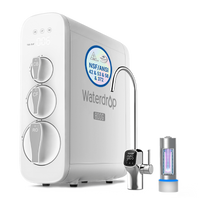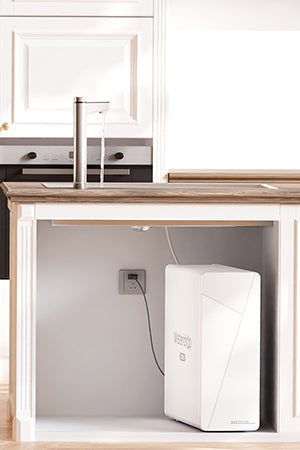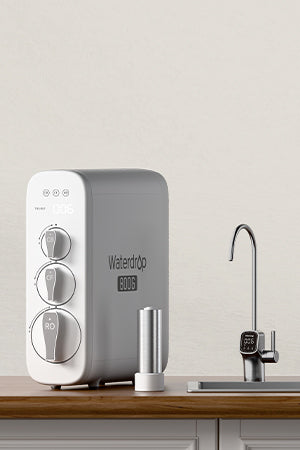The quality of the local tap water is becoming a major talking point among Americans. A recent
NSF survey reported that most Americans do not know exactly what their drinking water contains and are worried about the possible presence of contaminants. The
Flint water crisis also escalated these uncertainties, with most Americans unconvinced about the safety of their tap water.
Consequently, the
demand for water purifiers is increasing. While there are many options out there, research has shown that
reverse osmosis systems are the most efficient. In this blog, we offer a basic introduction to reverse osmosis and compare it with three other best seller RO systems of the moment.
Comparing the best-selling water purifiers in the market
This comparison aims to introduce you to three water purifier models – the Waterdrop, AEC, and iSpring. We have chosen these three most popular brands to give you a balanced comparison and help you make the right purchasing decision.
iSpring RCC7AK 6-Stage Under Sink Reverse Osmosis System
The traditional design of this iSpring RO system means the filters are of the cartridge types, sitting in the recyclable clear plastic housing. The filter setup allows this system to do basic filtration and remineralization, i.e., the addition of beneficial minerals to your water post-filtration. There is also a large water tank for storing filtered water.
Only the inner filter needs a replacement after expiration. In terms of efficiency, the system produces three gallons of wastewater for every gallon of clean water. This is similar to the average efficiency most traditional RO systems provide.
Advantages
- This system is effective against up to 99% contaminants.
- With the remineralization filter ensuring you don’t miss out on the beneficial minerals.
- The water storage tank is pre-pressurized and has a 4-gallon capacity.
- You can easily detect a leakage with the alarm kit included in the box.
- Depending on your water use, you can get up to 75 GPD daily output on average.
- All of these features come at a relatively affordable price.
Disadvantages
- There are three cups of wastewater for every cup of pure water produced.
- This RO system also requires a larger under sink space and may leak out water at the connecting joints.
APEC Tier 5-Stage Reverse Osmosis Drinking Water Filter System
The impressive features and low price of this RO system easily make it one of the most popular models on Amazon. It is similar to the iSpring RO system in appearance, specifications, and installation. The basic filtration function is almost the same for both models, except for the absence of a remineralization stage in the APEC RO system.
Advantages
- This reverse osmosis drinking water filter system is competitively priced.
- Offering a 4-gallon pre-pressurized tank for storing water.
- RO membrane of 2-3 years lifespan.
Disadvantages
- You only get 50 gallons per day with this system, which is quite low.
- Each cup of pure water is produced at the expense of three cups of wastewater.
- You may struggle with the installation.
- There is no remineralization stage.
Waterdrop G3 RO Reverse Osmosis Water Filtration System
The two previously-mentioned filtration systems are traditional, but this Waterdrop RO system offers something different. First, its innovative tankless design means the system can conveniently slot under most under-sink space. Second, it comes with a stronger internal pump that raises the daily output to 400 GPD. Finally, unlike the traditional filter setup, the Waterdrop G3 has a composite filter technology, where a filter handles multiple stages of filtration.
Advantages
- You get a RO system with a tankless design, removing the risk of bacteria breeding in the tank and helping you save under sink space.
- The 400 GPD daily output is one of the best out there.
- 1:1 super-low drain ratio.
- The composite filter setup offers a better filtration effect.
- The system comes with a smart indicator system.
- Installation in 3 minutes, with the filter replacement taking just 3 seconds.
Disadvantages
- The Waterdrop G3 RO Reverse Osmosis Water Filtration System can be an expensive option.
- It offers no remineralization stage.
Start by assessing your budget. You spend less on traditional systems – they cost almost half of the prices of the tankless systems. But the price is the only competitive advantage of the tanked RO systems. The tankless models are better off with a space-saving design, efficient filtration performance, smart functionality, large filter capacity, and seamless installation and maintenance.
Reverse Osmosis Explained
What is the working principle?
As the name suggests, reverse osmosis is a form of an osmosis but in the reverse direction. There is a reverse osmosis membrane in the mix – a
semi-permeable membrane through which the unclean water is pressured to remove the contaminants present. The 0.0001-micron rating of the membrane guarantees precise filtration, ensuring that all impurities larger than that size are trapped. In the end, only the pure water molecules go through the membrane.
Why should you use a RO system?
To improve the quality of your drinking water.
Reverse osmosis systems are designed to filter your water in four to five stages, using increasingly finer membranes to get rid of
contaminants present. The multi-stage filtration process removes pharmaceuticals, viruses, TDS, sulfates, salts, protozoa, nitrates, magnesium, lead, fluoride, copper, calcium, and bacteria. It also removes odor and improves taste.
To save money.
Buying
bottled water seems convenient, but it is costly. However, splashing out the cash on a RO system can be a cost-effective purchase in the long run. Aside from being a more environment-friendly alternative, it also helps you save money while serving you the best clean and filtered water.
Other Tankless RO Systems You Can Consider
Waterdrop D6 RO Reverse Osmosis Water Filtration System
The Waterdrop D6 is cheaper than the G3 while offering similar performance. The 5-in-1 composite reverse osmosis filter and a DOW reverse osmosis membrane with a 0.001-micron pore size deliver an excellent filtration performance. The flow rate here is 600 GPD – higher than the G3. You only sacrifice 1 cup of wastewater for every 1.5 cups of pure water the system filters. That is 450% of water saved, compared to the traditional filtration systems.
Waterdrop G2MNR RO Reverse Osmosis Water Filtration System with Remineralization
The filter set up in the Waterdrop G2MNR comprises a CF filter, an MRO filter, and an add-on remineralization filter, delivering a seven-stage filtration. The compact design means the system only requires a little under sink space. At a 400 GPD, you only need 12 seconds to fill a cup with filtered water. The drain ratio is also very low at 1:1, helping you save 300% more wastewater. The most important feature of this RO system is the remineralization stage, which restores the beneficial minerals into your filtered water. Waterdrop also ensured the precise ratio between microelements, using the PPC mineral active technology.








































































